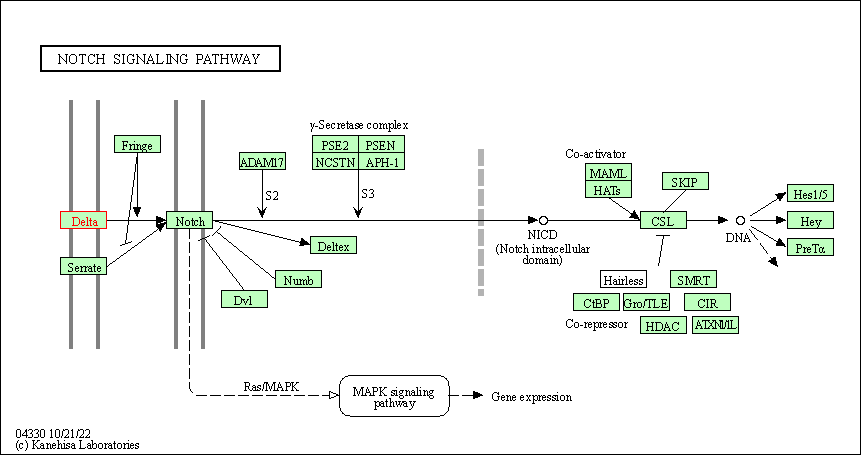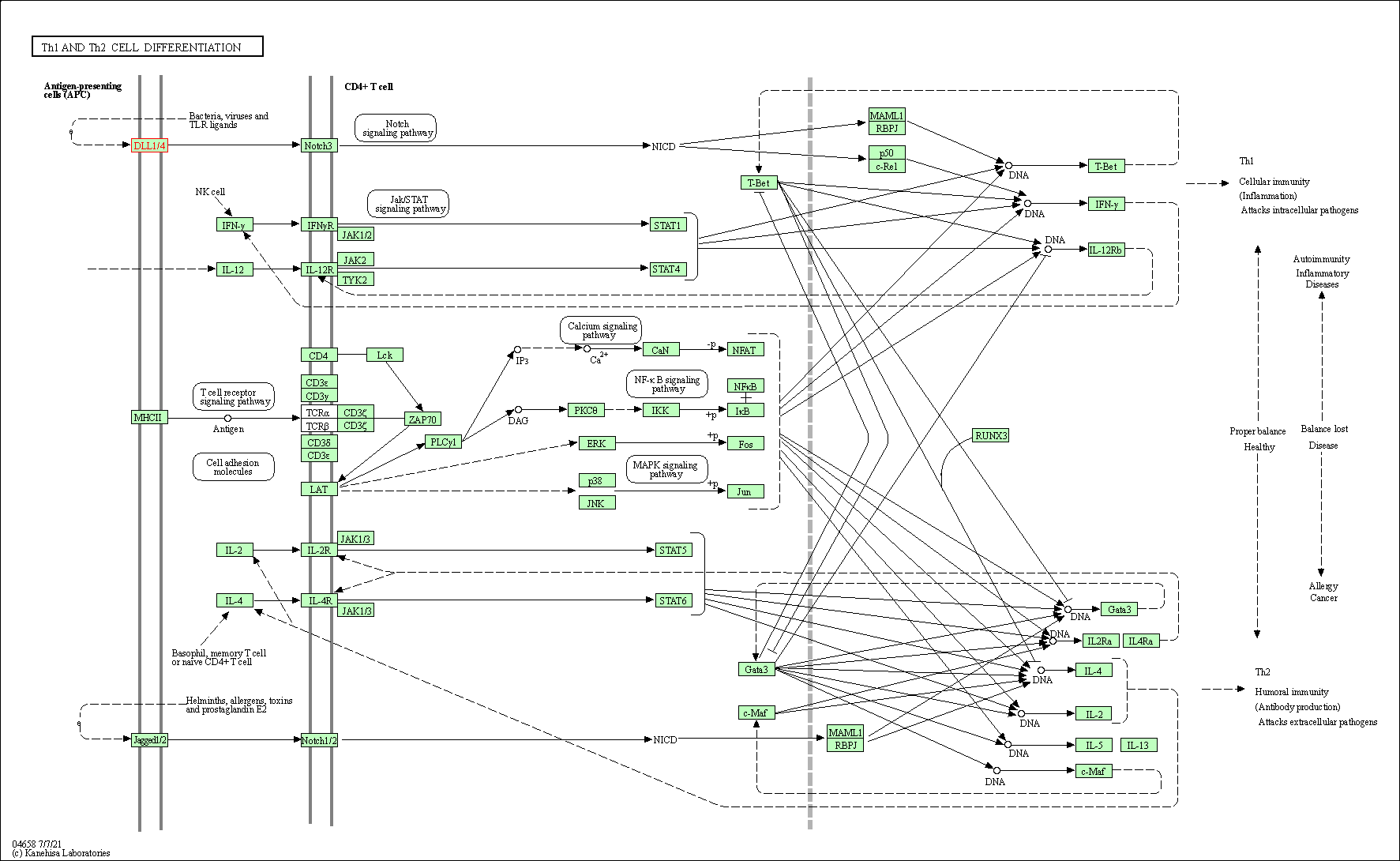Target Information
| Target General Information | Top | |||||
|---|---|---|---|---|---|---|
| Target ID |
T55273
(Former ID: TTDNC00397)
|
|||||
| Target Name |
Delta-like protein 4 (DLL4)
|
|||||
| Synonyms |
UNQ1895/PRO4341; Drosophila Delta homolog 4; Deltalike protein 4; Delta4
Click to Show/Hide
|
|||||
| Gene Name |
DLL4
|
|||||
| Target Type |
Clinical trial target
|
[1] | ||||
| Disease | [+] 5 Target-related Diseases | + | ||||
| 1 | Solid tumour/cancer [ICD-11: 2A00-2F9Z] | |||||
| 2 | Colorectal cancer [ICD-11: 2B91] | |||||
| 3 | Fallopian tube cancer [ICD-11: 2C74] | |||||
| 4 | Ovarian cancer [ICD-11: 2C73] | |||||
| 5 | Peritoneal cancer [ICD-11: 2C51] | |||||
| Function |
Activates NOTCH1 and NOTCH4. Involved in angiogenesis; negatively regulates endothelial cell proliferation and migration and angiogenic sprouting. Essential for retinal progenitor proliferation. Required for suppressing rod fates in late retinal progenitors as well as for proper generation of other retinal cell types. During spinal cord neurogenesis, inhibits V2a interneuron fate. Involved in the Notch signaling pathway as Notch ligand.
Click to Show/Hide
|
|||||
| UniProt ID | ||||||
| Sequence |
MAAASRSASGWALLLLVALWQQRAAGSGVFQLQLQEFINERGVLASGRPCEPGCRTFFRV
CLKHFQAVVSPGPCTFGTVSTPVLGTNSFAVRDDSSGGGRNPLQLPFNFTWPGTFSLIIE AWHAPGDDLRPEALPPDALISKIAIQGSLAVGQNWLLDEQTSTLTRLRYSYRVICSDNYY GDNCSRLCKKRNDHFGHYVCQPDGNLSCLPGWTGEYCQQPICLSGCHEQNGYCSKPAECL CRPGWQGRLCNECIPHNGCRHGTCSTPWQCTCDEGWGGLFCDQDLNYCTHHSPCKNGATC SNSGQRSYTCTCRPGYTGVDCELELSECDSNPCRNGGSCKDQEDGYHCLCPPGYYGLHCE HSTLSCADSPCFNGGSCRERNQGANYACECPPNFTGSNCEKKVDRCTSNPCANGGQCLNR GPSRMCRCRPGFTGTYCELHVSDCARNPCAHGGTCHDLENGLMCTCPAGFSGRRCEVRTS IDACASSPCFNRATCYTDLSTDTFVCNCPYGFVGSRCEFPVGLPPSFPWVAVSLGVGLAV LLVLLGMVAVAVRQLRLRRPDDGSREAMNNLSDFQKDNLIPAAQLKNTNQKKELEVDCGL DKSNCGKQQNHTLDYNLAPGPLGRGTMPGKFPHSDKSLGEKAPLRLHSEKPECRISAICS PRDSMYQSVCLISEERNECVIATEV Click to Show/Hide
|
|||||
| 3D Structure | Click to Show 3D Structure of This Target | AlphaFold | ||||
| Drugs and Modes of Action | Top | |||||
|---|---|---|---|---|---|---|
| Clinical Trial Drug(s) | [+] 6 Clinical Trial Drugs | + | ||||
| 1 | Dilpacimab | Drug Info | Phase 2 | Solid tumour/cancer | [2] | |
| 2 | ABT-165 | Drug Info | Phase 1 | Solid tumour/cancer | [3] | |
| 3 | Navicixizumab | Drug Info | Phase 1 | Colorectal cancer | [4] | |
| 4 | NOV1501 | Drug Info | Phase 1 | Solid tumour/cancer | [5] | |
| 5 | OMP-21M18 | Drug Info | Phase 1 | Solid tumour/cancer | [6], [7], [8] | |
| 6 | REGN-421 | Drug Info | Phase 1 | Solid tumour/cancer | [9] | |
| Mode of Action | [+] 2 Modes of Action | + | ||||
| Inhibitor | [+] 2 Inhibitor drugs | + | ||||
| 1 | ABT-165 | Drug Info | [3] | |||
| 2 | NOV1501 | Drug Info | [11] | |||
| Modulator | [+] 1 Modulator drugs | + | ||||
| 1 | OMP-21M18 | Drug Info | [12] | |||
| Cell-based Target Expression Variations | Top | |||||
|---|---|---|---|---|---|---|
| Cell-based Target Expression Variations | ||||||
| Drug Binding Sites of Target | Top | |||||
|---|---|---|---|---|---|---|
| Ligand Name: alpha-L-Fucose | Ligand Info | |||||
| Structure Description | Human DLL4 C2-EGF3 | PDB:5MVX | ||||
| Method | X-ray diffraction | Resolution | 2.17 Å | Mutation | No | [13] |
| PDB Sequence |
SGVFQLQLQE
36 FINERGVLAS46 GRPCEPGCRT56 FFRVCLKHFQ66 AVVSPGPCTF76 GTVSTPVLGT 86 NSFAVRDDSS96 GGGRNPLQLP106 FNFTWPGTFS116 LIIEAWHAPG126 DDLRPEALPP 136 DALISKIAIQ146 GSLAVGQNWL156 LDEQTSTLTR166 LRYSYRVICS176 DNYYGDNCSR 186 LCKKRNDHFG196 HYVCQPDGNL206 SCLPGWTGEY216 CQQPICLSGC226 HEQNGYCSKP 236 AECLCRPGWQ246 GRLCNECIPH256 NGCRHGTCST266 PWQCTCDEGW276 GGLFCDQDLN 286 YCTHHSPCKN296 GATCSNSGQR306 SYTCTCRPGY316 TGVDCELEL
|
|||||
|
|
||||||
| Click to View More Binding Site Information of This Target with Different Ligands | ||||||
| Different Human System Profiles of Target | Top |
|---|---|
|
Human Similarity Proteins
of target is determined by comparing the sequence similarity of all human proteins with the target based on BLAST. The similarity proteins for a target are defined as the proteins with E-value < 0.005 and outside the protein families of the target.
A target that has fewer human similarity proteins outside its family is commonly regarded to possess a greater capacity to avoid undesired interactions and thus increase the possibility of finding successful drugs
(Brief Bioinform, 21: 649-662, 2020).
Human Pathway Affiliation
of target is determined by the life-essential pathways provided on KEGG database. The target-affiliated pathways were defined based on the following two criteria (a) the pathways of the studied target should be life-essential for both healthy individuals and patients, and (b) the studied target should occupy an upstream position in the pathways and therefore had the ability to regulate biological function.
Targets involved in a fewer pathways have greater likelihood to be successfully developed, while those associated with more human pathways increase the chance of undesirable interferences with other human processes
(Pharmacol Rev, 58: 259-279, 2006).
Biological Network Descriptors
of target is determined based on a human protein-protein interactions (PPI) network consisting of 9,309 proteins and 52,713 PPIs, which were with a high confidence score of ≥ 0.95 collected from STRING database.
The network properties of targets based on protein-protein interactions (PPIs) have been widely adopted for the assessment of target’s druggability. Proteins with high node degree tend to have a high impact on network function through multiple interactions, while proteins with high betweenness centrality are regarded to be central for communication in interaction networks and regulate the flow of signaling information
(Front Pharmacol, 9, 1245, 2018;
Curr Opin Struct Biol. 44:134-142, 2017).
Human Similarity Proteins
Human Pathway Affiliation
Biological Network Descriptors
|
|
| KEGG Pathway | Pathway ID | Affiliated Target | Pathway Map |
|---|---|---|---|
| Notch signaling pathway | hsa04330 | Affiliated Target |

|
| Class: Environmental Information Processing => Signal transduction | Pathway Hierarchy | ||
| Th1 and Th2 cell differentiation | hsa04658 | Affiliated Target |

|
| Class: Organismal Systems => Immune system | Pathway Hierarchy | ||
| Degree | 6 | Degree centrality | 6.45E-04 | Betweenness centrality | 9.54E-06 |
|---|---|---|---|---|---|
| Closeness centrality | 1.86E-01 | Radiality | 1.31E+01 | Clustering coefficient | 3.33E-01 |
| Neighborhood connectivity | 1.30E+01 | Topological coefficient | 3.21E-01 | Eccentricity | 13 |
| Download | Click to Download the Full PPI Network of This Target | ||||
| Target Regulators | Top | |||||
|---|---|---|---|---|---|---|
| Target-regulating microRNAs | ||||||
| Target Affiliated Biological Pathways | Top | |||||
|---|---|---|---|---|---|---|
| KEGG Pathway | [+] 1 KEGG Pathways | + | ||||
| 1 | Notch signaling pathway | |||||
| NetPath Pathway | [+] 1 NetPath Pathways | + | ||||
| 1 | Notch Signaling Pathway | |||||
| Panther Pathway | [+] 2 Panther Pathways | + | ||||
| 1 | Angiogenesis | |||||
| 2 | Notch signaling pathway | |||||
| PID Pathway | [+] 1 PID Pathways | + | ||||
| 1 | Notch signaling pathway | |||||
| Reactome | [+] 7 Reactome Pathways | + | ||||
| 1 | Activated NOTCH1 Transmits Signal to the Nucleus | |||||
| 2 | Constitutive Signaling by NOTCH1 PEST Domain Mutants | |||||
| 3 | Constitutive Signaling by NOTCH1 t(7 | |||||
| 4 | M1580_K2555) Translocation Mutant | |||||
| 5 | Constitutive Signaling by NOTCH1 HD Domain Mutants | |||||
| 6 | Constitutive Signaling by NOTCH1 HD+PEST Domain Mutants | |||||
| 7 | NOTCH2 Activation and Transmission of Signal to the Nucleus | |||||
| WikiPathways | [+] 7 WikiPathways | + | ||||
| 1 | Notch Signaling Pathway | |||||
| 2 | Signaling by NOTCH3 | |||||
| 3 | Signaling by NOTCH4 | |||||
| 4 | Signaling by NOTCH1 | |||||
| 5 | Signaling by NOTCH2 | |||||
| 6 | Notch Signaling Pathway | |||||
| 7 | Neural Crest Differentiation | |||||
| References | Top | |||||
|---|---|---|---|---|---|---|
| REF 1 | J Clin Oncol 31, 2013 (suppl; abstr 2502). | |||||
| REF 2 | ClinicalTrials.gov (NCT03368859) A Study of ABT-165 Plus FOLFIRI vs Bevacizumab Plus FOLFIRI in Subjects With Metastatic Colorectal Cancer Previously Treated With Fluoropyrimidine, Oxaliplatin and Bevacizumab. U.S. National Institutes of Health. | |||||
| REF 3 | Clinical pipeline report, company report or official report of the Pharmaceutical Research and Manufacturers of America (PhRMA) | |||||
| REF 4 | Clinical pipeline report, company report or official report of the Pharmaceutical Research and Manufacturers of America (PhRMA) | |||||
| REF 5 | ClinicalTrials.gov (NCT03292783) This is a Study to Evaluate the Safety and Tolerability of the Study Drug ABL001, and to Determine the Maximum Tolerated Dose and/or Recommended Phase 2 Study Dose of ABL001. U.S. National Institutes of Health. | |||||
| REF 6 | URL: http://www.guidetopharmacology.org Nucleic Acids Res. 2015 Oct 12. pii: gkv1037. The IUPHAR/BPS Guide to PHARMACOLOGY in 2016: towards curated quantitative interactions between 1300 protein targets and 6000 ligands. (Ligand id: 8451). | |||||
| REF 7 | ClinicalTrials.gov (NCT00744562) A Phase 1 Dose Escalation Study of OMP-21M18 in Subjects With Solid Tumors. U.S. National Institutes of Health. | |||||
| REF 8 | Clinical pipeline report, company report or official report of OncoMed Pharmaceuticals. | |||||
| REF 9 | ClinicalTrials.gov (NCT00871559) A Multiple-Ascending-Dose Study of the Safety and Tolerability of REGN421(SAR153192) in Patients With Advanced Solid Malignancies. U.S. National Institutes of Health. | |||||
| REF 10 | Apoptogenic activity of 2alpha,3alpha-dihydroxyurs-12-ene-28-oic acid from Prunella vulgaris var. lilacina is mediated via mitochondria-dependent activation of caspase cascade regulated by Bcl-2 in human acute leukemia Jurkat T cells. J Ethnopharmacol. 2011 Jun 1;135(3):626-35. | |||||
| REF 11 | Synergistic antitumor activity of a DLL4/VEGF bispecific therapeutic antibody in combination with irinotecan in gastric cancer. BMB Rep. 2020 Nov;53(10):533-538. | |||||
| REF 12 | National Cancer Institute Drug Dictionary (drug id 614677). | |||||
| REF 13 | Structural and functional dissection of the interplay between lipid and Notch binding by human Notch ligands. EMBO J. 2017 Aug 1;36(15):2204-2215. | |||||
If You Find Any Error in Data or Bug in Web Service, Please Kindly Report It to Dr. Zhou and Dr. Zhang.

